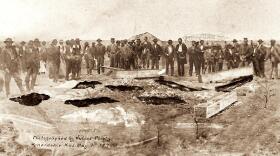Since 1920, the Osawatomie/Paola game was the Super Bowl, the game no one missed, the big one that shut down both Kansas towns and most the countryside. For 93 years it went on.
But the rivalry got started long before that, if you read the history. For a time in the 1850s, those two burgs did a whole lot more than mount great passing games. Kansas was bleeding in the 1850s. Just about everyone opening up the sod on the new state's eastern edge did so because they wanted to fight, wanted to win, sometimes at all costs.

Back then, it was the Free-Soilers vs. the Border Ruffians, the abolitionists vs. the slavers; and the sides couldn't have been much different or more hostile. The abolitionists were New Englanders, Puritans at heart, if not in confession, men and women dedicated to righteousness, sworn into God's army to end slavery.
Some settlers wanted a new life, but around Osawatomie, most newcomers arrived because Congress had ruled that whether Kansas were slave or free would be decided by those who lived there. Hundreds, even thousands, came west--John Brown among them, the John Brown--because they were doing the Lord's work, fighting the abomination of slavery.
When you're south of Kansas City some time, stop at Osawatomie, Ground Zero of the Bleeding Kansas of the 1850s. Follow Main Street all the way through town to a park where you can't miss an odd stone edifice that encloses the log cabin John Brown--"Osawatomie Brown"--used as headquarters during the twenty months he spent at war in "Bleeding Kansas.”
The enemy Border Ruffians were equally determined, even if they invoked God's name a good deal less than the holy abolitionists. They were Southerners, determined to protect a way of life from the Yankees they hated. Once upon a time, neighboring Paola, just down the road, was populated heavily by Border Ruffians.
On August 30, 1856, a couple hundred or more Border Ruffians rode into Osawatomie, intending to burn out the New Englanders, then keep on riding to Topeka and Lawrence and leave the whole region in flame. First, they shot John Brown's son Frederick dead. Then, a couple dozen armed abolitionists tried to hold them off, but their numbers were pitiful, even if their bravery wasn’t. Soon the Free-Staters, out of ammo, scattered, and the Slavers torched most every building in town.

There was more terror in Bleeding Kansas, more blood in the neighborhood, more killing, some of it--much of it--cold-blooded on both sides. All of that right there in the countryside, right there in two little Middlewestern small towns. That old cabin looks far more comfortable than it was.
Some historians claim what happened in little Osawatomie, and throughout the border region, was the opening salvo of the Civil War. It's hard to argue that it wasn’t, even though Beauregard didn't fire on Ft. Sumter until April 12, 1861, almost five years later.
You can see John Brown's hat there in the cabin--the one he was wearing at Harper's Ferry; and his saddle, and a broad portrait of the man, a likeness nothing at all like the wide-eyed fanatic who jumps off the mural in the Kansas State Capital.
All those John Brown things are in the back room of the cabin, a back room once hidden from view, frequently--if the stories can be believed--a temporary stop on the Underground Railroad. If you stand there, even for a moment, try to imagine what simply can't be imagined, especially if you're white, a roomful of fearful people, worried sick about being caught, but fiercely determined to be free.
---
Support for Small Wonders on Siouxland Public Media comes from the Daniels Osborn Law Firm in the Ho Chunk Centre in downtown Sioux City, serving needs of clients in real estate transactions; business formation and guidance; and personal estate planning. More information is available on Facebook or at danielsosborn.com.






